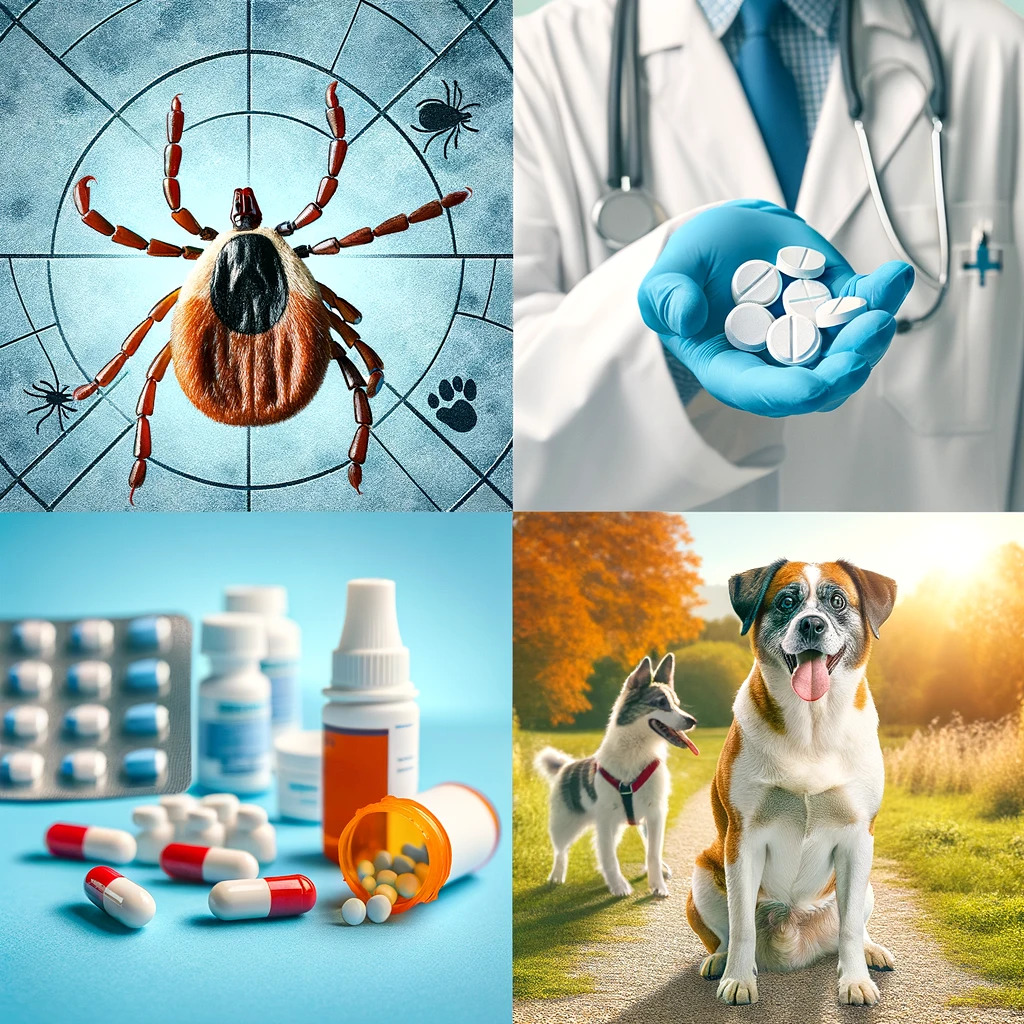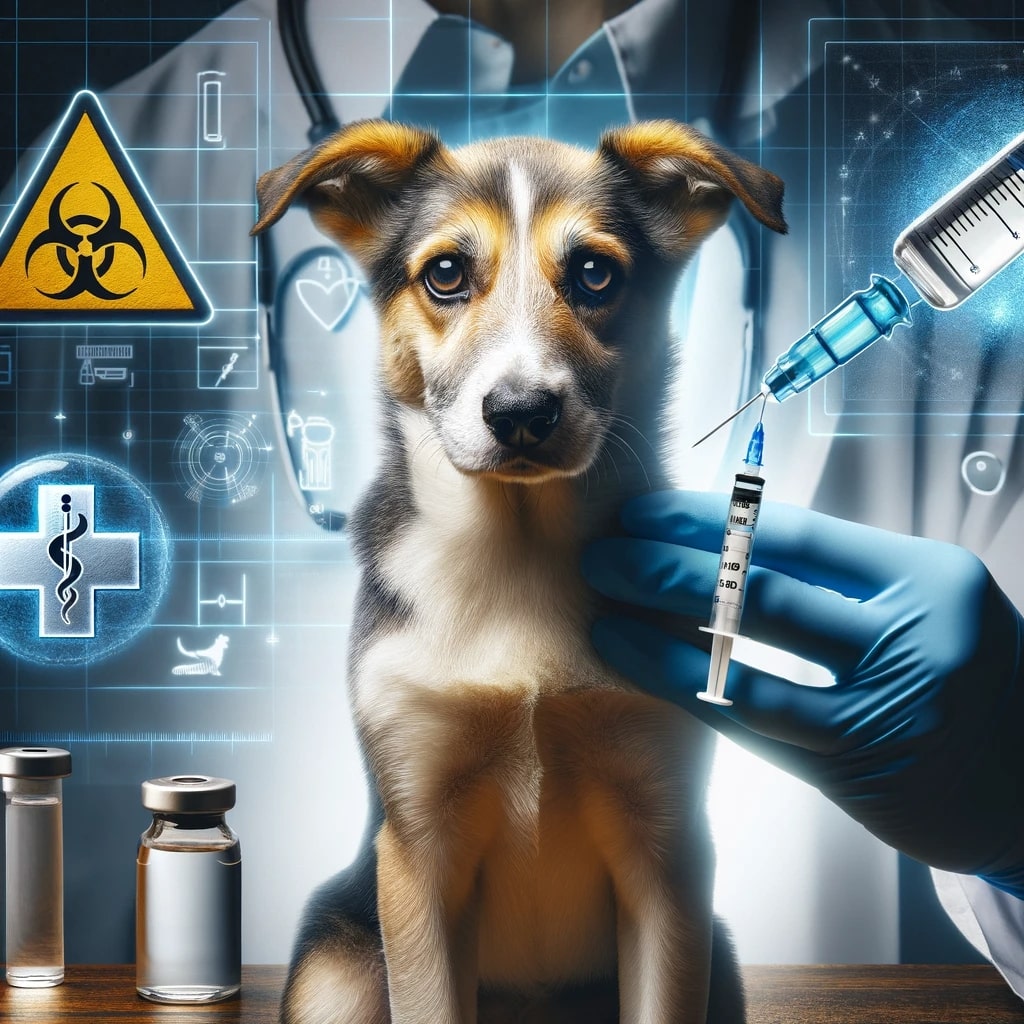Rickettsial diseases in dogs are caused by a group of microorganisms that can be transmitted by fleas, ticks, and other vectors. Understanding these diseases is crucial for pet owners to ensure the health and well-being of their furry companions. In this comprehensive guide, we will explore the most commonly asked questions about rickettsial diseases in dogs, providing in-depth answers and insights.
1. What are Rickettsial Diseases and How Do They Affect Dogs?
Rickettsial diseases are a group of vector-borne illnesses caused by bacteria belonging to the Rickettsia genus. These bacteria are primarily transmitted to dogs through bites from infected ticks, fleas, or mites. The impact of these diseases on dogs can range from mild to severe, affecting various systems in the body.
Understanding the Bacteria
Rickettsial bacteria are intracellular pathogens, meaning they invade and live within the cells of their host. This nature makes them particularly challenging to treat, as they are somewhat protected from the host’s immune system.
Common Types of Rickettsial Diseases in Dogs
- Rocky Mountain Spotted Fever (RMSF): Caused by Rickettsia rickettsii, transmitted by tick bites. Symptoms include fever, joint pain, and skin lesions.
- Ehrlichiosis: Caused by various species of the Ehrlichia genus. Symptoms include fever, weight loss, and respiratory distress.
- Anaplasmosis: Caused by Anaplasma phagocytophilum, with symptoms similar to Ehrlichiosis.
- Tick Fever or Boutonneuse Fever: Caused by Rickettsia conorii or Rickettsia africae.
Symptoms of Rickettsial Diseases in Dogs
- Fever
- Lethargy
- Loss of appetite
- Joint pain and stiffness
- Coughing and difficulty breathing
- Skin rashes or lesions
- Swollen lymph nodes
Diagnosis
Diagnosing rickettsial diseases involves a combination of clinical signs, history of possible exposure to vectors, and laboratory tests, including blood tests and PCR (Polymerase Chain Reaction) testing.
Treatment and Management
The primary treatment for rickettsial diseases is antibiotics, typically doxycycline. Early diagnosis and treatment are crucial for the best outcomes. Supportive care may include pain management, anti-inflammatory medications, and intravenous fluids.
Prevention
Prevention strategies include:
- Regular use of tick and flea preventatives.
- Checking your dog for ticks after outdoor activities.
- Keeping your yard clean and free from tall grasses and brush.
- Vaccination, where available.
Prognosis
The prognosis for dogs with rickettsial diseases varies. Early detection and treatment usually result in a good prognosis, but severe cases, especially if not treated promptly, can lead to more serious complications.
2. How is a Dog Diagnosed with a Rickettsial Disease?
Diagnosing a rickettsial disease in dogs involves a comprehensive approach, considering both clinical signs and specific diagnostic tests. Given the complexity of these diseases, a thorough diagnosis is essential for effective treatment.
Recognizing the Symptoms
The first step in diagnosing a rickettsial disease is recognizing its symptoms:
- Fever
- Lethargy
- Loss of appetite
- Joint pain
- Respiratory issues
- Skin lesions
Veterinary Examination
A thorough veterinary examination is crucial. This includes:
- Review of the dog’s medical history.
- Physical examination, focusing on areas like joints, skin, and lymph nodes.
- Discussion of possible exposure to ticks or fleas.
Laboratory Tests
Several laboratory tests are used to diagnose rickettsial diseases:
- Complete Blood Count (CBC): Can show signs of infection, anemia, or platelet issues.
- Biochemistry Profile: Assesses organ function.
- Serological Testing: Detects antibodies against Rickettsia.
- PCR Testing: Identifies Rickettsial DNA in blood or tissue samples.
Imaging
In some cases, imaging such as X-rays or ultrasounds might be needed to evaluate organ involvement or complications.
Differential Diagnosis
Rickettsial diseases can mimic other conditions. Differential diagnosis is vital to rule out other possible causes of the symptoms.
Treatment Plan
Once diagnosed, a treatment plan involving antibiotics (commonly doxycycline) and supportive care is initiated. The effectiveness of treatment depends on the disease’s severity and the promptness of intervention.
Follow-Up
Regular follow-up visits are necessary to monitor the dog’s response to treatment and adjust the treatment plan as needed.
Importance of Early Detection
Early detection and treatment are critical in managing rickettsial diseases effectively. Delayed treatment can lead to severe complications and a poorer prognosis.
Monitoring for Complications
During treatment, dogs should be monitored for potential complications, such as kidney or liver involvement, which may require additional interventions.
Collaborative Care
In some cases, collaboration with specialists, such as a veterinary infectious disease expert or an internist, may be beneficial to provide the best care for the dog.
3. What Are the Long-Term Effects of Rickettsial Diseases in Dogs?
Understanding the long-term effects of rickettsial diseases is crucial for pet owners. These effects can vary based on the disease’s severity, the dog’s overall health, and the timeliness of treatment.
Potential Chronic Conditions
Some dogs may develop chronic conditions following a rickettsial infection, such as:
- Chronic joint pain or arthritis.
- Ongoing kidney or liver problems.
- Persistent neurological symptoms.
Impact on Quality of Life
Long-term effects can impact a dog’s quality of life, requiring ongoing management and sometimes lifestyle adjustments.
Monitoring and Management
Regular veterinary check-ups are essential for dogs that have recovered from a rickettsial disease to monitor for any long-term issues.
Importance of Ongoing Care
Ongoing care, including appropriate nutrition, regular exercise, and continued use of vector preventatives, is vital for maintaining the health of a dog that has had a rickettsial disease.
Potential for Relapse
In some cases, there may be a potential for relapse, particularly if the initial infection was not fully resolved. Regular monitoring for any return of symptoms is crucial.
Research and Advances
Research into the long-term effects of rickettsial diseases is ongoing, and new treatments and management strategies are continually being developed.
Support for Pet Owners
Support for pet owners dealing with the long-term effects of rickettsial diseases is important. This can include educational resources, support groups, and counseling.
Role of Rehabilitation
Rehabilitation therapies, such as physical therapy, can be beneficial for dogs recovering from severe rickettsial diseases, especially those with joint or muscle issues.
Holistic and Supportive Therapies
Holistic and supportive therapies, such as acupuncture or hydrotherapy, may be helpful adjuncts to conventional treatment in managing long-term effects.
The Importance of a Positive Environment
Finally, providing a positive, stress-free environment is essential for the overall well-being of dogs recovering from rickettsial diseases. Love, comfort, and a calm home can significantly contribute to their health and happiness.
4. Can Rickettsial Diseases in Dogs be Prevented?
Prevention of rickettsial diseases is key to protecting dogs from these serious infections. While complete prevention may not always be possible, there are several effective strategies to reduce the risk.
Vector Control
The most critical aspect of prevention is controlling the vectors – ticks, fleas, and mites – that transmit these diseases.
- Regular Use of Preventatives: Flea and tick preventatives, in the form of collars, topical treatments, or oral medications, should be used regularly.
- Environmental Control: Keeping the environment clean by mowing lawns, removing leaf litter, and avoiding wooded or brushy areas where vectors thrive.
Regular Health Check-Ups
Regular veterinary check-ups help in early detection and prevention of rickettsial diseases. Discussing the best preventative strategies with your veterinarian is essential.
Awareness and Education
Educating pet owners about the risks and signs of rickettsial diseases is crucial. Awareness about the areas where these diseases are more prevalent can help in taking proactive measures.
Vaccination
Where available, vaccination against certain rickettsial diseases can provide an additional layer of protection.
Checking for Ticks
Regularly checking your dog for ticks, especially after outdoor activities, and promptly removing any ticks found is vital.
Travel Precautions
If traveling with your pet to areas known for rickettsial diseases, extra precautions should be taken, including consulting a veterinarian about additional preventatives.
Hygiene
Maintaining good hygiene, especially after outdoor activities, can help prevent the spread of these diseases.
Community Efforts
Community-wide efforts, such as tick control programs, can also contribute to the prevention of rickettsial diseases.
Considerations for At-Risk Dogs
Extra care should be taken for dogs that are at higher risk, such as those with weakened immune systems or those living in endemic areas.
Role of Research
Ongoing research into rickettsial diseases helps in developing better prevention strategies, including new and more effective vaccines and treatments.
Prevention of rickettsial diseases in dogs requires a multifaceted approach, involving both individual actions and community-wide efforts. Through vigilant prevention strategies, the risk of these diseases can be significantly reduced, ensuring the health and well-being of our canine companions.
5. How is Rickettsial Disease Treated in Dogs?
Treatment of rickettsial diseases in dogs is a critical component of managing these infections. The approach to treatment typically involves a combination of antibiotic therapy and supportive care.
Antibiotic Therapy
- Doxycycline: The primary antibiotic used for treating rickettsial diseases. It’s effective against most Rickettsia species.
- Duration of Treatment: Treatment usually lasts for at least 2-4 weeks, depending on the severity of the disease and the dog’s response to therapy.
- Monitoring Antibiotic Efficacy: Regular follow-up is needed to ensure the effectiveness of the antibiotic and to adjust the treatment if necessary.
Supportive Care
- Fluid Therapy: For dogs with dehydration or kidney involvement, intravenous or subcutaneous fluids may be administered.
- Pain Management: If the dog is experiencing pain, especially joint pain, appropriate pain relievers will be prescribed.
- Anti-Inflammatory Medications: These may be used to reduce inflammation and fever.
Managing Complications
- Organ Support: If organs such as the liver or kidneys are affected, specific treatments to support these organs may be necessary.
- Blood Transfusions: In cases with severe anemia or blood clotting disorders, blood transfusions might be required.
Importance of Completing the Treatment
It’s crucial for pet owners to complete the full course of antibiotics even if their dog seems to be improving, to ensure the bacteria are fully eradicated.
Alternative Treatments
In cases where a dog cannot tolerate doxycycline, alternative antibiotics may be considered under veterinary guidance.
Prognosis
With timely and appropriate treatment, many dogs recover fully from rickettsial diseases. However, the prognosis depends on the disease’s severity and the dog’s overall health.
Regular Monitoring
Regular monitoring during and after treatment is essential to assess the dog’s response to treatment and to detect any potential relapses or complications.
Collaborative Approach
In some cases, a collaborative approach involving specialists in infectious diseases or internal medicine may be beneficial.
Owner’s Role in Treatment
Pet owners play a crucial role in the treatment process by administering medications, monitoring their dog’s condition, and ensuring regular veterinary follow-ups.
Preventative Measures Post-Recovery
After recovery, it’s important to continue with preventative measures to reduce the risk of re-infection.
6. What Are the Early Signs of Rickettsial Disease in Dogs?
Early detection of rickettsial diseases can significantly improve the prognosis. Recognizing the early signs is crucial for prompt veterinary care.
Common Early Symptoms
- Fever: Often one of the first signs, characterized by increased body temperature.
- Lethargy: Lack of energy or a noticeable decrease in activity levels.
- Loss of Appetite: Decreased interest in food.
- Joint Pain: Stiffness or discomfort, particularly after resting.
- Swollen Lymph Nodes: Enlarged lymph nodes can sometimes be felt under the skin.
Behavioral Changes
Changes in behavior, such as increased irritability or depression, may also be early indicators of a rickettsial disease.
Skin and Coat Changes
Rashes, lesions, or unusual spots on the skin, as well as changes in the coat’s condition, can be early signs.
Respiratory Symptoms
Coughing or difficulty breathing may occur in some cases, depending on the specific rickettsial disease.
Gastrointestinal Symptoms
Symptoms such as vomiting or diarrhea, though less common, can be early signs of some rickettsial diseases.
Importance of Tick Checks
Regularly checking for and promptly removing ticks can help prevent rickettsial diseases and aid in identifying a potential cause if symptoms develop.
When to See a Veterinarian
If any of these early signs are observed, especially following potential exposure to ticks or fleas, it’s important to consult a veterinarian as soon as possible.
Diagnostic Testing
Early diagnostic testing, including blood tests and possibly PCR testing, can be crucial for early detection and treatment.
Monitoring High-Risk Dogs
Dogs in areas with high tick populations or those who frequently engage in outdoor activities should be monitored closely for early signs.
Owner Awareness
Pet owner awareness and education about rickettsial diseases are key to recognizing early signs and seeking timely veterinary care.
7. Are Certain Breeds More Susceptible to Rickettsial Diseases?
When it comes to rickettsial diseases in dogs, breed susceptibility is an important aspect to consider. While all dogs can be affected by these diseases, certain factors related to specific breeds may increase their risk.
Factors Influencing Breed Susceptibility
- Outdoor Exposure: Breeds that spend more time outdoors, especially in wooded or grassy areas, are at a higher risk due to increased exposure to ticks.
- Coat Type: Dogs with thicker coats may be more prone to tick infestations, as ticks can hide more easily in dense fur.
- Size and Height: Smaller breeds or breeds closer to the ground may have a higher risk of encountering ticks and other vectors.
Commonly Affected Breeds
While any dog can contract a rickettsial disease, certain breeds may be more frequently diagnosed. This could be due to their lifestyle, habitat, or genetic factors.
Genetic Predisposition
Research is ongoing to determine if there are genetic predispositions in some breeds that make them more susceptible to these diseases.
Importance of Preventative Care for All Breeds
Regardless of breed, all dogs should receive regular preventative care against ticks and fleas. This includes the use of preventive medications and environmental control measures.
Regular Vet Check-Ups
Regular veterinary check-ups are essential for early detection and treatment, especially for breeds at a higher risk.
Owner Education
Owners should be educated about the risks of rickettsial diseases, especially if they own a breed that may be more susceptible.
Environmental Management
Managing the dog’s environment, such as keeping the yard clean and avoiding high-risk areas, is crucial in preventing tick exposure.
Monitoring for Symptoms
Owners of breeds that may be at higher risk should be particularly vigilant in monitoring for symptoms of rickettsial diseases.
Research and Development
Continued research into breed-specific susceptibilities can help in developing targeted prevention and treatment strategies.
Collaborative Approach
A collaborative approach involving veterinarians, breeders, and pet owners is key to understanding and managing breed-specific risks related to rickettsial diseases.
8. What is the Recovery Process Like for Dogs with Rickettsial Diseases?
Recovery from rickettsial diseases in dogs varies depending on the severity of the disease, the timeliness of treatment, and the individual dog’s health. Understanding the recovery process is crucial for pet owners to provide the best care for their recovering pet.
Post-Treatment Monitoring
- Regular Veterinary Check-ups: Ongoing check-ups are essential to monitor the dog’s recovery and to address any complications.
- Blood Tests: Repeat blood tests may be necessary to assess the response to treatment and check for lingering effects.
Recovery Time
The recovery time can range from a few weeks to several months, depending on the severity of the infection and the dog’s overall health.
Home Care
- Medication Compliance: Ensuring that the dog completes the entire course of prescribed antibiotics and any other medications.
- Rest and Confinement: Limiting physical activity to allow the dog’s body to heal.
- Nutritional Support: Providing a balanced diet to support recovery.
Physical Rehabilitation
In cases of severe joint pain or muscle weakness, physical rehabilitation may be recommended to aid in recovery.
Behavioral and Emotional Support
Some dogs may experience behavioral changes or stress during recovery. Emotional support and a calm environment can aid in their healing process.
Preventing Re-Infection
Continued use of tick and flea preventatives is crucial to prevent re-infection.
Recognizing and Addressing Complications
Being vigilant for signs of complications and addressing them promptly is essential for a full recovery.
Support and Resources for Owners
Owners may need support and resources to navigate their dog’s recovery process, including educational materials and support groups.
Celebrating Milestones
Acknowledging and celebrating milestones in the dog’s recovery can be encouraging for both the pet and the owner.
Long-Term Management
In some cases, long-term management may be required for residual effects of the disease. This includes regular veterinary visits and possible adjustments in lifestyle and care.
Recovery from rickettsial diseases requires a comprehensive and attentive approach. With proper care, most dogs can recover fully and return to their normal lives. Pet owners play a crucial role in this process, providing the necessary care, monitoring, and support for their recovering canine companions.
9. Can Rickettsial Diseases in Dogs be Fatal?
The potential fatality of rickettsial diseases in dogs is a serious concern for pet owners. While many dogs can recover with appropriate treatment, these diseases can be life-threatening in certain situations.
Factors Influencing Fatality
- Severity of the Disease: Advanced stages of the disease or severe symptoms increase the risk of fatality.
- Timeliness of Treatment: Delayed diagnosis and treatment can lead to complications, increasing the risk of a fatal outcome.
- Underlying Health Conditions: Dogs with pre-existing health conditions or weakened immune systems may be more susceptible to severe outcomes.
Common Fatal Complications
- Kidney Failure: Rickettsial diseases can cause acute kidney injury, leading to potentially fatal complications.
- Severe Anemia and Blood Clotting Disorders: These conditions can lead to life-threatening situations if not managed promptly.
- Respiratory Distress: In severe cases, respiratory complications can occur, posing a significant risk.
Statistics on Fatality Rates
While exact fatality rates vary depending on the specific rickettsial disease and other factors, prompt and effective treatment generally leads to a good prognosis.
Importance of Early Detection
Early detection and treatment are key factors in reducing the risk of fatality. Recognizing symptoms and seeking veterinary care promptly can make a critical difference.
Advanced Care Options
In severe cases, advanced care, including hospitalization and intensive treatment, may be necessary to manage life-threatening complications.
Owner’s Role in Prevention and Early Treatment
Pet owners play a crucial role in prevention, early recognition of symptoms, and seeking timely veterinary care, all of which are critical in reducing the risk of fatality.
Supportive Care
Supportive care, including fluids, nutrition, and oxygen therapy, can be vital in managing severe cases and improving outcomes.
Ongoing Research and Treatment Advances
Continued research and advancements in veterinary medicine are improving the treatment and management of rickettsial diseases, potentially reducing fatality rates.
Educating Pet Owners
Educating pet owners about the risks, symptoms, and the importance of preventive measures is crucial in the fight against these diseases.
Coping with Loss
For those who lose a pet to a rickettsial disease, support and counseling may be necessary to cope with the loss.
Rickettsial diseases, while treatable, can be serious and potentially fatal in some cases. Understanding the risks, recognizing the symptoms early, and providing timely, effective treatment are key to improving the prognosis for affected dogs.
10. What Research is Being Done on Rickettsial Diseases in Dogs?
The field of veterinary medicine is continuously evolving, and research on rickettsial diseases in dogs is an important part of this progress. Understanding current research efforts can provide insights into future treatment options and preventive measures.
Focus Areas of Research
- Vaccine Development: Research is ongoing to develop effective vaccines against various rickettsial diseases.
- Diagnostic Tools: Improving diagnostic tools for early and accurate detection of these diseases.
- Treatment Protocols: Developing more effective treatment protocols and alternative treatments for dogs that cannot tolerate standard medications.
- Vector Control: Studying the vectors (ticks, fleas, mites) to develop better control and prevention strategies.
Clinical Trials
Clinical trials are an essential part of research, testing new treatments, vaccines, and diagnostic methods under controlled conditions.
Genetic Studies
Research into the genetic predispositions of certain breeds or individuals to rickettsial diseases can provide insights into prevention and treatment strategies.
Global Studies
Studying rickettsial diseases in different geographical areas helps understand the variations in disease presentation and response to treatment.
Collaborative Efforts
Collaboration between veterinarians, researchers, and public health experts is crucial in advancing our understanding and management of these diseases.
Funding and Support
Securing funding and support for research is vital for ongoing studies and advancements in this field.
Public Awareness and Education
Raising public awareness about rickettsial diseases and the importance of research is key in garnering support and participation in research efforts.
The Role of Pet Owners
Pet owners can contribute to research efforts by participating in studies, reporting cases, and supporting research initiatives.
Future Perspectives
Research is continually shaping the future of veterinary medicine, with the potential for significant advancements in the prevention, diagnosis, and treatment of rickettsial diseases in dogs.
Staying Informed
For pet owners and veterinarians, staying informed about the latest research findings is important for providing the best possible care for dogs at risk of or affected by rickettsial diseases.
Conclusion
Rickettsial diseases in dogs present a complex and challenging aspect of veterinary medicine. From understanding the nature of these diseases, recognizing early signs, to managing treatment and recovery, each aspect requires careful consideration and knowledge. This comprehensive guide has explored various facets of rickettsial diseases, offering insights into their diagnosis, treatment, and long-term management.
As pet owners, understanding these diseases is crucial for the well-being of our furry friends. Early detection, prompt treatment, and effective prevention strategies play a key role in managing these conditions. It’s important to maintain regular veterinary check-ups, stay vigilant for any signs of illness, and adhere to preventive measures against ticks and fleas.
The role of ongoing research cannot be overstated. Advances in veterinary medicine continue to improve our ability to diagnose, treat, and prevent rickettsial diseases. Staying informed about these advancements helps in providing the best care for our dogs.
Ultimately, our goal is to ensure a high quality of life for our pets. By being proactive about their health, understanding the risks of diseases like rickettsia, and working closely with veterinarians, we can help our canine companions lead happy, healthy lives. Remember, the love and care we provide for our pets make a significant difference in their health and well-being.
Summary Table
| Topic | Details |
| Nature of Rickettsial Diseases | Caused by bacteria from the Rickettsia genus, transmitted by vectors like ticks, fleas, and mites. |
| Symptoms | Fever, lethargy, loss of appetite, joint pain, skin lesions, coughing, swollen lymph nodes. |
| Diagnosis | Through symptoms, exposure history, blood tests, and PCR testing. |
| Treatment | Mainly antibiotics (e.g., doxycycline), supportive care, managing complications. |
| Prevention | Use of tick/flea preventatives, environmental control, regular vet check-ups, possible vaccination. |
| Recovery | Depends on severity and treatment; involves post-treatment monitoring, home care, and possibly rehabilitation. |
| Risk Factors | Outdoor exposure, breed susceptibility, pre-existing health conditions. |
| Research | Focuses on vaccine development, improved diagnostics, treatment protocols, and vector control. |
Frequently Asked Questions
Common rickettsial diseases in dogs include Rocky Mountain Spotted Fever, Ehrlichiosis, Anaplasmosis, and Tick Fever.
Symptoms include fever, lethargy, loss of appetite, joint pain, skin lesions, and swollen lymph nodes. Always consult a veterinarian for a proper diagnosis.
Yes, with timely and appropriate antibiotic treatment, many dogs recover fully. Early detection and treatment are crucial.
Regular use of tick and flea preventatives, maintaining a clean environment, and regular veterinary check-ups are effective prevention strategies.
While all dogs can be affected, breeds with more outdoor exposure or certain genetic predispositions might be at higher risk.
Consult a veterinarian immediately. Early diagnosis and treatment are key to a successful recovery.
Yes, ongoing research focuses on vaccine development, better diagnostic tools, and more effective treatment protocols.



